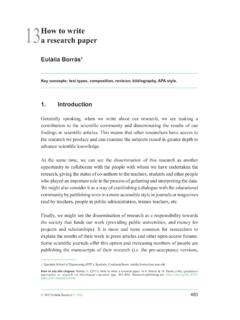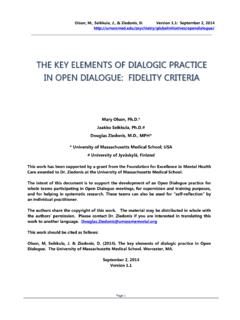Transcription of CHAPTER FOUR Qualitative Research
1 11/3/10 9:55 AM Page 39. Jones & Bartlett Learning, LLC. NOT FOR SALE OR DISTRIBUTION. C H A P T E R F O U R. Qualitative Research R. esearch methods that delve deeply into experiences, social processes, and subcultures are referred to as Qualitative Research . As a group, Qualitative Research methods: Recognize that every individual is situated in an unfolding life context, that is, a set of circumstances, values, and influences Respect the meanings each individual assigns to what happens to and around him or her Recognize that cultures and subcultures are diverse and have consid- erable effect on individuals Qualitative researchers feel strongly that a person's experiences, percep- tions, and social interactions are not reducible to numbers and categories . they are much too complex and situated in the context of a person's life. They believe that the researcher attempting to understand experiences, perception, and social interaction must enter into a person's life-world and let the partic- ipant's words and accounts lead the researcher to understandings that would remain hidden without deep and open-minded exploration (Munhall, 2007).
2 Thus, Qualitative researchers go into their exploration with as few assump- tions as possible. 39. 11/3/10 9:55 AM Page 40. Jones & Bartlett Learning, LLC. NOT FOR SALE OR DISTRIBUTION. 40 CHAPTER 4 Qualitative Research Data Collection and Analysis The data collection techniques used to understand subjective realities include: Nonintrusive, often prolonged, observation Conversational interviews Open-ended questions Careful listening Follow-up questions Helping persons to be reflective about their experiences Requesting elaboration Validation (when making an interpretation of observations or what was said, ask the informant if the interpretation is accurate). Often, detailed notes are kept or interviews are recorded and subse- quently transcribed. The researcher spends considerable time going back and forth through the notes to identify important connections. As the researcher gains greater insight into the issue, the questions asked of subse- quent study participants may change (Swanson, 2001).
3 The researcher works inductively, that is: moving from details to a slightly more general encompassing phrase or concept, and finally to a set of themes or patterns that portrays important aspects of the experience, social process, or culture. The term Qualitative Research actually refers to methodological traditions and methods with diverse aims, data collection techniques, and analysis techniques. The methodological traditions were developed in disciplines such as sociology and anthropology and nursing has adopted them (see Table 4 1). The phenomenological Research tradition is useful in gaining insight into human experiences, whereas the grounded theory tradition enables researchers to understand the fundamental social processes involved in healthcare situa- tions, say, the workings of emergency care transports or how families make the decision for a child to have an organ transplant.
4 The ethnographic Research tradition creates descriptions of healthcare subcultures, such as chronic renal dialysis units or Alzheimer support groups from the insider perspective. Two other Qualitative Research traditions are discourse analysis and historical analysis. Discourse analysis is used to analyze the dynamics and structure of conversations, such as patient provider dialogue . Historical Research examines past events and trends, usually through records, documents, articles, and per- sonal diaries from the past. Table 4 1 Qualitative Research METHODS. TRADITION COMMON AIM IN NURSING STUDIES DATA COLLECTION TECHNIQUES DATA ANALYSIS TECHNIQUES. Phenomenologic To produce understanding of the 1. Select persons who are living 1. Transcribe interviews. Research lived experience of persons with or have lived the experience. 2. Look for segments a particular health condition 2.
5 Set aside preconceived ideas. in the account. or situation 3. Engage in dialogue with 3. Identify significant each participant. phrases. 11/3/10. 4. Explore the person's life-world. 4. Group phrases with 5. Assist person to be reflective common thoughts about his or her experiences into themes. and what they mean to him 5. Confirm themes with 9:55 AM. or her. the participants. 6. Stay in the setting until no new insights are emerging Page 41. and all issues are understood. Ethnographic To produce a rich portrayal of the 1. Immerse self in the culture/ 1. Identification of social Research norms, values, language, roles, setting, typically for long rules and and social rules of a health or periods of time. understandings. health care culture or subculture 2. Observe social 2. Analysis of social interactions. networks. 3. Seek out and informally 3. Confirmation of question good informants.
6 Interpretations. 4. Analyze documents. 4. Produce a coherent 5. Take detailed notes. account of the culture. Jones & Bartlett Learning, LLC. NOT FOR SALE OR DISTRIBUTION. 5. Check out description Data Collection and Analysis with key informants. 41. (continued). 42. Table 4 1 (CONTINUED). TRADITION COMMON AIM IN NURSING STUDIES DATA COLLECTION TECHNIQUES DATA ANALYSIS TECHNIQUES. Grounded theory To produce a theory 1. Gain access to the social setting. 1. Intermix data collec- Research ( , a tentative, coherent 2. Observe social interactions. tion and analysis. explanation) about how a social 3. Conduct informal interviews. 2. Name what is process works 4. Keep field notes. happening in the 11/3/10. 5. Identify useful written materials. data with codes. 6. Stay in the setting until no new 3. Analyze the insights are emerging and all use of language. issues are well understood.
7 4. Proceed from concrete 9:55 AM. codes to theoretical ones. 5. Constantly compare CHAPTER 4 Qualitative Research new data with Page 42. previously acquired data. 6. Generate hypotheses and check them out with participants. Jones & Bartlett Learning, LLC. NOT FOR SALE OR DISTRIBUTION. 11/3/10 9:55 AM Page 43. Jones & Bartlett Learning, LLC. NOT FOR SALE OR DISTRIBUTION. Qualitative Description 43. Each of these traditions requires techniques for collecting and analyzing data appropriate to its purposes. After looking across the rows of Table 4 1, which will give you a sense for each tradition, look down the columns and note how the purposes and methods of these traditions differ. Qualitative Description Not all questions in nursing and healthcare can be investigated in a clini- cally useful way using the methods of one of the traditions just described. As a result another method that draws on features from the traditional approaches has evolved.
8 This somewhat eclectic approach is called qualita- tive description (Neergaard, Olesen, Andersen, & Sondegaard, 2009;. Sandelowski, 2000, 2010; Thorne, Kirkham, & MacDonald-Emes, 1997). The goal of Qualitative description is to produce a straightforward descrip- tion of participants' experiences in words as similar to what the participants said as possible. Most often, but not always, the participants are patients. Commonly used methods of Qualitative description include, but are not lim- ited to the following: 1. Sampling for diversity 2. Data collection by interviews of individual or focus groups 3. Data analysis by Qualitative content analysis 4. Generation of themes or patterns that capture what has been said Even quantitative data collection and analysis techniques can be incorpo- rated into a study using the Qualitative description method. Understanding how Qualitative content analysis is done is key to under- standing this Qualitative Research method.
9 If you think about it, you will realize that Qualitative data collection produces an abundance of data . pages and pages of transcripts of interviews and dialogue or of written material. To extract meaning from all this raw data, researchers identify sec- tions of data that convey an idea and assign it a word or phrase code that conveys its essence. The code should be data-derived, , generated from the data itself (Sandelowski, 2000). In assigning a code to a section of tran- scribed narrative or a section of a diary, the researcher is always aware that she is making an interpretation and therefore must be careful that the code does not change the original meaning of what was said. Content analysis is not a linear, constantly forward-moving process. Rather, it is dynamic and reflexive. If none of the previously used codes cap- tures the meaning of a section of text, the researcher will create a new code.
10 11/3/10 9:55 AM Page 44. Jones & Bartlett Learning, LLC. NOT FOR SALE OR DISTRIBUTION. 44 CHAPTER 4 Qualitative Research The new code may or may not lead the researcher to revise the coding of already coded text. A list of codes can be informative, but it may be more useful if coding is taken a step further. That step involves identifying similarities in the codes;. it may be possible to group similar codes without losing the meaning of the first round of codes. This broader grouping may be a category, a chrono- logical order, or a theme. Again, the researcher is on guard to not lose the meaning of the original data and codes. Original quote Code Several similar codes Theme Importantly, even though Qualitative description is somewhat eclectic in the methods used, researchers who use it remain committed to rigor of method by using methodological principles widely recognized by other Qualitative researchers.














